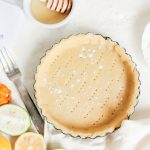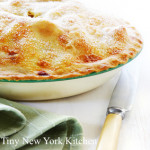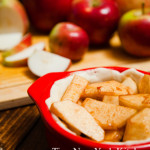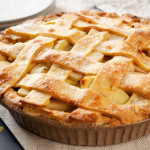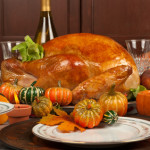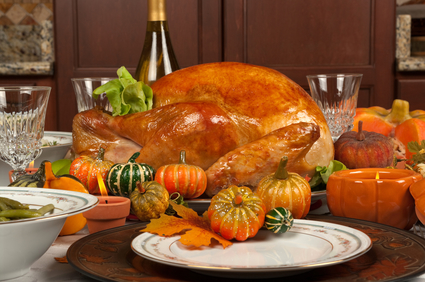Warm Dough
Make sure not to let the dough get warm. Use cold butter and ice water. Refrigerate the dough before you roll it out. If the butter warms it will be absorbed by the flour, become sticky, and make for a tough crust.
Uneven Crust
To get an even, round crust, begin rolling from the middle of the dough round, pushing outward and stopping the pressure 1/4 inch from the edge. Then lift the round, give it a quarter turn and repeat.
Transferring Crust
To transfer your pie dough from the rolling surface to the pie plate, lift it with a bench scraper, gently drape it over a rolling pin, then place it in the pie plate.
©Tiny New York Kitchen © 2020 All Rights Reserved
There are four versions of classic pie dough. 1. All butter dough has excellent flavor, but can be tricky to use. 2. Butter and shortening dough is flakier and more tender. It browns slightly faster than all butter dough, but has less shrinkage and holds its shape better during baking. 3. Lard pie dough creates the flakiest, crispiest, and most tender dough of all, but the flavor is fairly bland. This dough also has the least amount of shrinkage when it bakes and it browns more slowly. 4. Butter and lard dough has superb flavor and texture. The ratio of butter to lard or butter to shortening varies from recipe to recipe, but most call for half butter, half alternative fat.
Starting with cold ingredients are key to a flaky crust. Using ice water and cold fat (butter or shortening) is important. Chill the dough for about an hour before rolling to help prevent sticking. When the pie crust goes in the oven, the cold shortening will stay solid long enough for the crust to set, creating small pockets in between the layers of dough as it melts resulting in a flaky crust.
Minimal handling is very important in helping to achieve a tender crust. Handle the dough just enough to mix it and roll it. Proper rolling is another way to avoid excess handling. Roll the dough from the center out, lifting the rolling pin after each roll.
To avoid soggy bottom crust in your fruit pie, get the filling into the piecrust and into the oven quickly. Drain off any excess juice in the bowl before pouring it into the piecrust.
For double crust fruit pies, cut slits in the top crust to allow steam to get out. The escaping moisture will help prevent soggy crusts.
Bake your pie in the lower third of the oven since this will allow the bottom crust to become crisp while the top shouldn’t get overly browned.
To cut down on the sugar in fruit pies, mix in a teaspoon or two of baking soda to the fruit before adding any sweetener. Then start out with adding 1/4 to 1/2 the amount of sugar that you normally would. The baking soda neutralizes the acid in the fruit, which means that it needs much less sweetening.
Allow the pie to cool 2 to 4 hours on a rack to room temperature or until barely warm, before slicing to ensure that the filling is set and will not run.
Slice apples thinly for apple pie. Thick slices promote air space and create a gap between the fruit and the crust and this may lead to a soggy crust.
Cornstarch is a good thickener to use with fruit to make a filling because it does not impart its own flavor and yields the smoothest texture. It also does not thin when reheating a slice of pie.
To enjoy fresh apple pie during the winter, freeze your prepared pie filling. Just cut up and slice your apples and toss them with whatever seasonings and thickener you normally put in your pie filling. Then freeze in a greased pie pan and when the apples are hard, lift them out and wrap for long-term freezing. When you want to enjoy an apple pie, all you have to do is place the ready-frozen pie filling in a crust and bake according to the recipe.
Baking a pie with a raw fruit filling will take a little longer than one with pre-cooked filling, about an hour longer. When using a pre-cooked filling, pies bake at a higher temperature for a shorter period of time, just enough to thoroughly bake the crust and heat the filling.
“Work With What You Got!”
© Victoria Hart Glavin Tiny New York Kitchen © 2016 All Rights Reserve
The Best Apples For Apple Pie
It’s apple pie season and it’s important to choose the best apples for apple pie. Choosing the right apples for baking can be a daunting task. I mean, seriously, there are over 7,5000 apple varieties. When it comes to pie not all apples are created equal. Choose a mix of firm & tart and firm & sweet varieties. Doing this adds diversity and depth of flavor, while holding their shape during the cooking process. No one wants a mushy pie.
Braeburn: A Firm & Sweet/Tart Variety Originating from New Zealand, Braeburn has a skin that’s muted red with golden-yellow undertones and tinges of faint green. It produces a firm, crisp bite and offers a pleasing balance between sweet and tart. Firm to the touch and great for baking as well as eating raw. Excellent when paired with Honeycrisp. Can be found in most supermarkets.
Granny Smith: A Firm & Tart Variety Classic green apple is firm, slightly sour, and perfect for pie making. It’s available everywhere.
Esopus Spitzenburg: A Firm & Tart Variety This is an heirloom variety that has flavors bright enough to make an excellent snack or pressed into cider. You’ll find this variety at farmers’ markets and makes a delicious pie filling.
Northern Spy: A Firm & Tart Variety Northern spy is thought to be the best apple variety for pies. Difficult to find at supermarkets, but many farmers’ markets have them.
Idared: A Firm & Tart Variety This tart and spicy apple is bright red in color when fully ripe. Not so easy to find in supermarkets, but popular at pick-your-own orchards and farmers’ markets.
Pink Pearl: A Firm & Tart Variety This variety is delicious and you’ll want to seek this variety out. Difficult to find, but can be found at some pick-your-own orchards. Search online in your area for a place to Pink Pearl.
Ginger Gold: A Firm & Sweet Variety Ginger Gold is a baker’s champion. This delicately sweet and crisp variety works well in pies, muffins, and cakes. Can be found in most supermarkets during autumn.
Golden Delicious: A Firm & Sweet Variety This is a mild tasting variety and is best when paired with heftier flavors. Very popular in the U.S. and can be found in any supermarket.
Honeycrisp: A Firm & Sweet Variety This is a crisp and predominately sweet variety. Very popular in the U.S. and can be found in most supermarkets. Great when paired with Braeburn for pie making.
Jazz: A Firm & Sweet Variety Great for eating raw as well as pie making. From New Zealand and can be found in most supermarkets.
Jonagold: A Firm & Sweet Variety A cross between Jonathan and Golden Delicious varieties. Sweet and tart flavor and can be used on its own. Can be found in both supermarkets and farmers’ markets.
Pink Lady: A Firm & Sweet Variety The perfect combination of sweet and sour. Pink Lady is excellent for baking as well as eating raw. Can be found in supermarkets and farmers’ markets.
A Word About McIntosh Apples: Mcintosh variety is a popular choice for many bakers, but I don’t recommend them on their own if you’re using them for pies. They just don’t hold up well to heat and tend to cook down into a sauce before the pie crust is done cooking. If you love the flavor of McIntosh apples and just have to use them in pies then combine them with a much firmer variety like Pink Lady, Jonagold, Honeycrisp, or Northern Spy.
“Work With What You Got!”
© Victoria Hart Glavin Tiny New York Kitchen © 2016 All Rights Reserved
Not sure how many apples you need to make an apple pie? One pound of apples is roughly 4 small, 3 medium, or 2 large apples. When you're making a 10 inch apple pie and the recipe calls for 2 1/2 pounds, then you will need 9 small, 7 medium, or 5 large apples.

